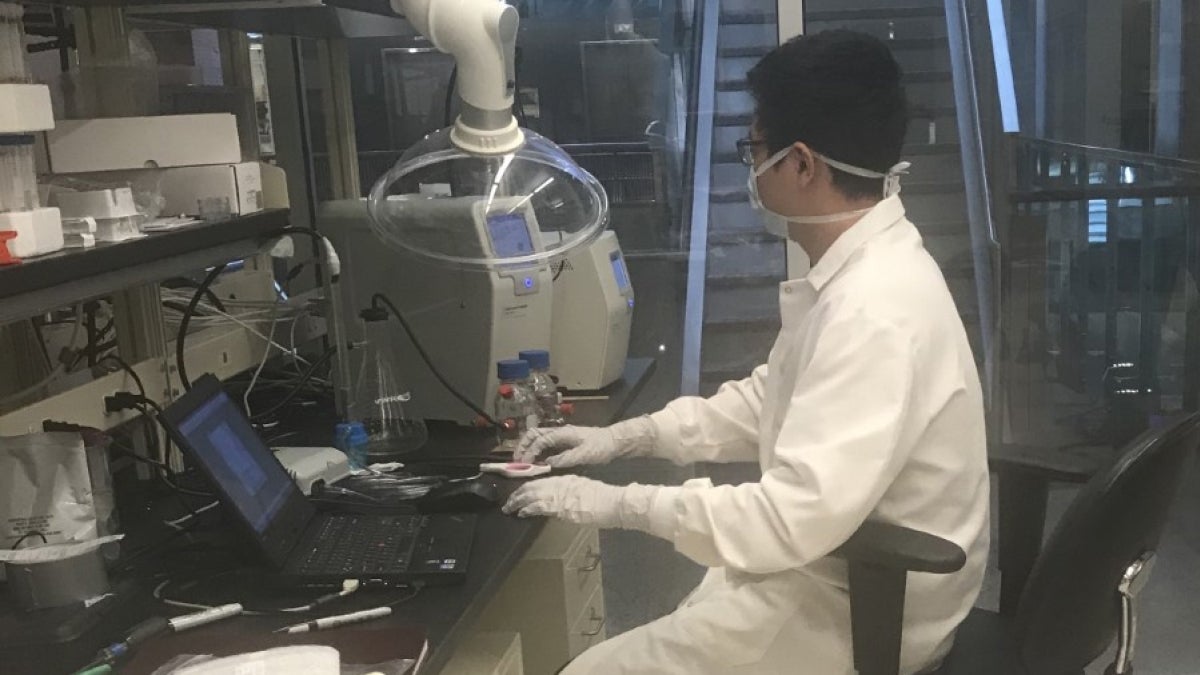ASU researcher tests face mask efficiency before and after sterilization

School of Molecular Sciences graduate student researcher Zhaobo Zhang tests the effectiveness of masks after sterilization.
Protective face masks are key to Arizona State University and other schools and organizations reopening because their use significantly decreases coronavirus spread. Some masks, in light of recent shortages, are being sterilized to allow reuse.
Sterilization, however, may alter mask structure and therefore the effectiveness of the mask’s ability to block small droplets and aerosols. Airborne particles and droplets, from a few nanometers to a few microns in size, are the research focus of School of Molecular Sciences Professor Pierre Herckes.
Herckes and his graduate student researcher, Zhaobo Zhang, were testing personal protective equipment (PPE) mask efficiency to trap nanoparticles in the semi-conductor industry prior to the COVID-19 outbreak. After the outbreak, they were approached by several groups to test mask efficiency before and after sterilization. Sterilization methods included treatment with ultraviolet (UV) light, ozone, or peroxide vapors. Before and after each of these sterilization methods, Herckes and Zhang tested the efficiency of masks to trap droplets and aerosols.
“What we found was there was not a significant decrease in mask efficiency before and after treatment," Herckes said. "However, further testing needs to be done to determine the effect of multiple treatments on the structure of mask materials.”
Herckes notes that their testing methods differ from National Institute for Occupational Safety and Health methods, but nevertheless provide important results.
Herckes is co-investigator with ASU engineering professor Paul Westerhoff on a recently funded National Science Foundation grant, “Disinfection and Reuse of Health-Care Worker Facial Masks to Prevent Infection coronavirus disease.” This grant allows Westerhoff and Herckes to test for change in mask efficiency after repeated UV-light exposure.
READ MORE: ASU rapidly engineers solution for medical staff battling COVID-19
“This research is important because we know very little about how UV-light modifies the molecular structure of protective masks,” Herckes said. Their work will also allow them to determine mask efficiency based on particle size and charge.
Large droplets, such as those produced when someone coughs or sneezes, are trapped to a great degree by a mask, and these droplets don’t travel as far as smaller droplets. Smaller droplets, however, are also capable of carrying coronavirus particles. Coronavirus particles are also transmitted by smaller particles, such as those produced by talking or breathing. These small droplets stay in the air much longer than large droplets, and they are inhaled more deeply into your lungs.
“Wear a mask, because it not only protects you, but it protects others,” Herckes said.
Protection from a mask is greatest when it is worn properly.
“Wearing a mask below your nose allows you to inhale and exhale droplets, so cover your nose with the mask, and make sure it fits properly around your face so there isn’t leakage from the sides,” he said. If air goes around the mask, it’s not effectively trapping particles.
Herckes also advises that you minimize touching your mask once it’s on.
“Your mask should be comfortable and not restrict air flow significantly," he said. "When you touch your mask, you are transmitting contaminants from your hands to your mask, and from your mask to your hands. More importantly, the mask will trap airborne virus particles, so you will be transferring these trapped particles to your hands, and then from your hands to whatever you touch, possibly your face, eyes and mouth.”
Washing your hands and wearing your mask are both important steps to staying healthy and reducing the spread of coronavirus.
More Science and technology

ASU professor honored with prestigious award for being a cybersecurity trailblazer
At first, he thought it was a drill.On Sept. 11, 2001, Gail-Joon Ahn sat in a conference room in Fort Meade, Maryland.…

Training stellar students to secure semiconductors
In the wetlands of King’s Bay, Georgia, the sail of a nuclear-powered Trident II Submarine laden with sophisticated computer…

ASU startup Crystal Sonic wins Natcast pitch competition
Crystal Sonic, an Arizona State University startup, won first place and $25,000 at the 2024 Natcast Startup Pitch Competition at…